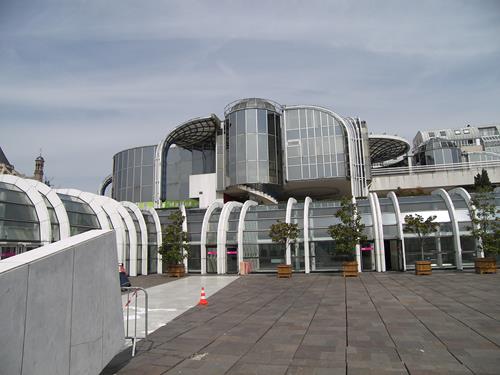
Quartier des Halles

| Once upon a time there
was a Cemetery, called the Cemetery of the Innocents b because its
church was dedicated to the Holy Innocents, the children killed by Herod
after the birth of Jesus. It was just outside Paris. Then the city grew
and engulfed it. By 1785 there were more dead people in Paris than live
ones. At the side of the cemetery was a charnel-house, a place where
bones were put when a grave was opened because, through lack of space,
it had to be re-used. (This is still standard practice in France, where
the basic plot in a cemetery is sold for a five-year term.) Near the
charnel-house was a drinking-fountain, the Fontaine des Innocents.
Opposite was a church, Saint-Eustache. In 1785 the charnel-house was
pulled down and the cemetery dug over. 1,200,000 skeletons were removed
and taken across town to the Catacombs. The site then became the central
food market of Paris. Under Napoleon III the architect Baltard built a
cast-iron covered market there, known as LES HALLES.
By 1968, this market was too small and too central to cope with the needs of six million Parisians, and it was moved out to Rungis, in the southern suburbs, leaving behind it a vast empty space in the heart of Paris. The argument over what to do with it went on for the next twenty years. First, the whole site was excavated to a depth of eighty feet, producing the largest hole in Europe. In this space were installed seven underground floors of shops, offices, car-parks and stations. The nucleus of the shopping centre, LE FORUM DES HALLES, opened in September 1979. It is on several floors, from the level of the metro station upwards, drawing light from a deep central well a hundred feet across. As well as some very expensive shops there are cafés and cinemas, and in the central space there are usually open-air performances going on. The rest of the space took another ten years to develop, mostly spent in argument over whether there should be skyscrapers. In the end, there is a new park, its alleyways named after poets, its entrances built of iron in the style of Baltard. It includes a children’s playground which look fabulous, but on which I am unable to report because adults are not allowed in. Underneath it, more shops, a library, a sports complex including swimming pools and billiard halls (not snooker, though; French billiard tables have no pockets), and Jacques Cousteau’s Ocean World. At the North side of the park a sort of arena faces the church of Saint Eustache, an oddity among buildings. If you simplify the principles of architecture, you can recognise several styles as follows: Greek - pillars and cross-beams; Romanesque - round arches; Gothic - great heart and pointed arches. Saint-Eustache, which was built at a moment when fashions were changing, has great height, round arches, and a façade with pillars and cross-beams. Inside, however – and it’s very spectacular inside –don’t miss ‘Le Départ des Halles’, a colourful sculpture showing all the market-people packing up and moving out in 1968. |